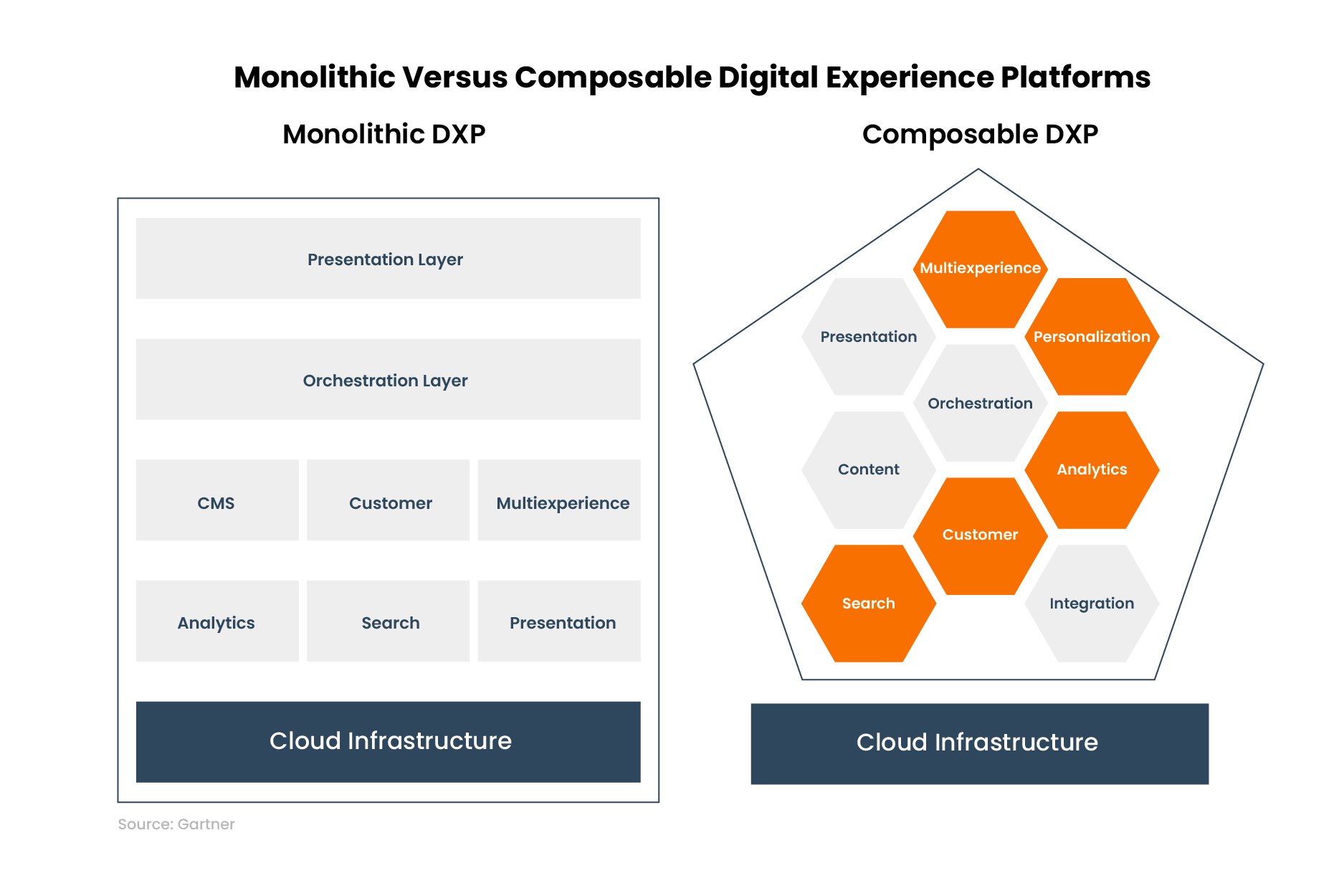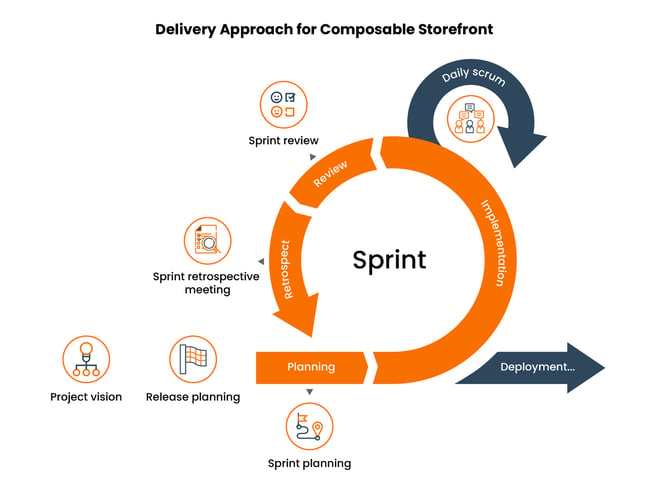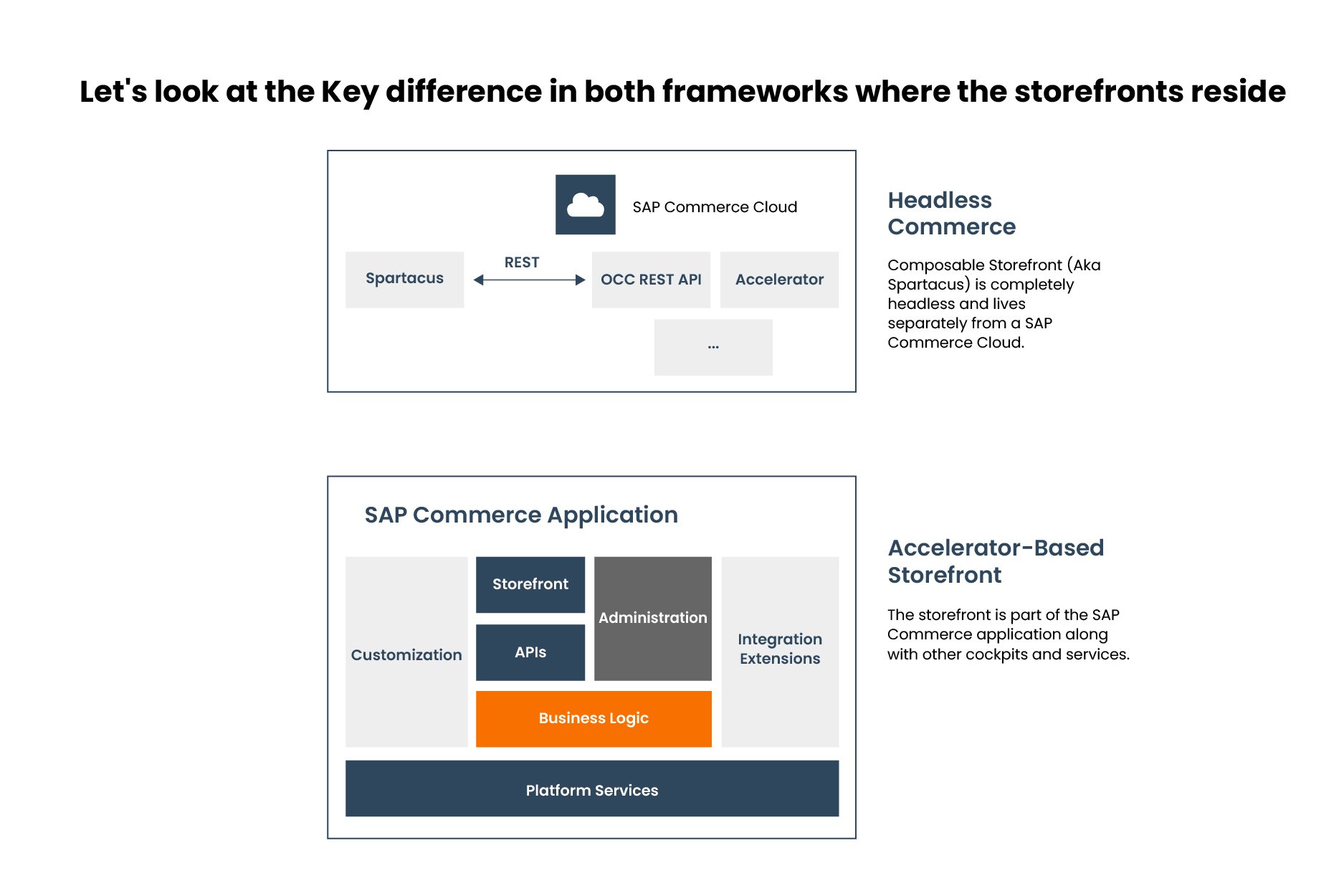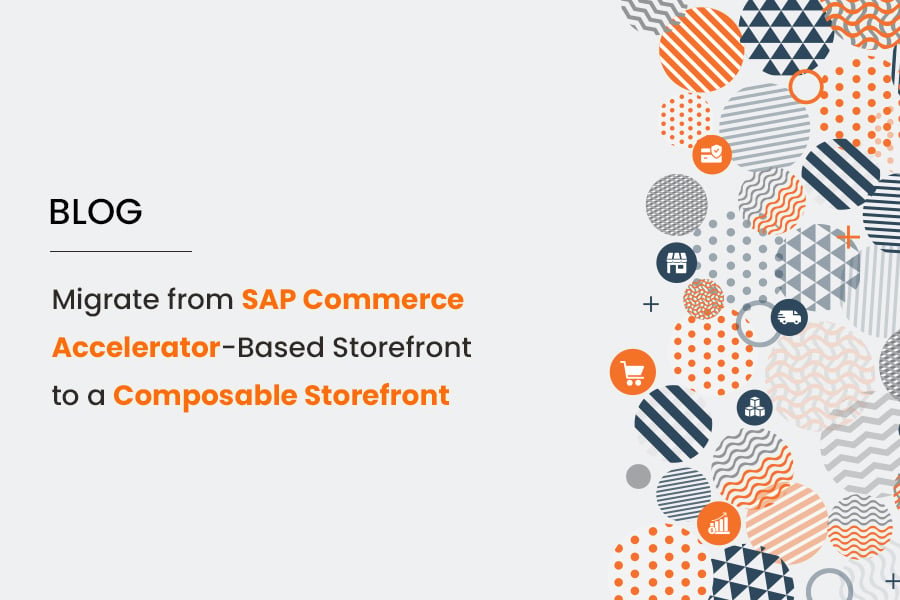Ecommerce Business Leaders: How scalable and sustainable is your storefront? Are you prepared for rapidly changing customer expectations?
Your customers aren’t the same as they used to be a year back. With lightning-speed integration of technologies like AI, they are overloaded with information and buying options. In a noise like this, how do you capture and retain your customers?
The only solution is to stay a step ahead of the competitors and implement agile systems and processes. Adapt your services and solutions to the changing market needs and create a customer experience that is unique, memorable, dynamic, personalized and pleasant. An experience that converts your customers into your brand advocates. For life.
A composable storefront helps you to achieve the above and more. In 2023, the composable storefront is replacing monolithic and omnichannel as the most desirable store experience.
Migrating your SAP commerce accelerator-based storefront to a composable storefront is a strategic move that can come with immense potential for your e-commerce operations.
In this article, our expert Bharath Yelugula takes you through the benefits and roadmap of composable storefronts. See what it can do for you and know whether it is the right solution for your business.
What is a Composable Storefront?
A composable storefront is a versatile framework where you and your customers can interact in a manner that serves you both best, the way you want it to.
In technical terms, SAP composable storefront is a collection of Javascript libraries. These can be used for the rapid development of storefronts for SAP Commerce. It utilizes headless architecture and angular framework to help you build your storefront as a PWA (Progressive Web Application).
“By 2023, organizations that have adopted a Composable Commerce approach will outpace the competition by 80% in the speed of new feature implementation.” — Gartner
Composable storefronts use packaged business capabilities to integrate accelerated functionalities in your storefront.
Why Migrate?
In today’s fast-evolving technologies and ever-rising customer demands, dependence on a single software can easily make you lose your business to your competition. There are multiple disadvantages to a traditional monolithic platform, the most prominent are scalability, load times and blanket customer experience.
Scalability
Monolithic software is complex to scale and difficult to adapt. There are large and complex codes and dependencies for the development team to deal with large databases, server-side interface and client-side interface. And launching updates requires redeployment and work.

To manage such a system, you need a large coding team, which often results in individual developers not understanding the website in its entirety. Changes in monolithic platforms require cost, time and huge effort.
Shrinking load times
Your commerce web page load speed directly impacts your conversion rates.
Optimal ecommerce conversion rates are within the 0-2 seconds range.
Beyond this limit, your conversions drop rapidly. On average, conversion rates decrease by 4.42% for every additional second of load time within the 0-5 second range, and by 2.11% within the 0-9 second range.
Personalization
Customers now seek hyper-personalization and seamless interactions. The purchasing process from adding an item to the cart to placing an order must be responsive, quick, CMS-centric, headless, and simple. Anything less than that will make your customers veer away to your competitor.
How Composable Storefront is Different from Headless Architecture?
Headless architecture or MACH architecture (Microservices-based, API-first, Cloud-native, and Headless), removes the link between the front end and back end providing more flexibility and freedom in return. Customers and site visitors see the front-end while the back-end is where orders are managed, customer data is collated, transactions occur, and payments are collected.
Headless eCommerce architecture can help you create flexible, unique, and channel-specific experiences – such as multilingual sites and omnichannel experiences. But headless commerce architecture only separates the front end from the back end. With composable eCommerce architecture, back-end elements are also separate.
Operational Benefits of Composable Storefront
A composable storefront is a win-win solution for business leaders, customers and the operational team.
A composable storefront will help you scale, accelerate and personalize your store experiences without stopping the platform as a whole.
Faster Implementation
A composable storefront is fast to develop. It’s a Single Page Application (SPA). The SPA accelerator already comes with the solution.
Headless Architecture
Composable storefronts are decoupled from SAP Commerce Cloud instances, enabling you to completely separate frontend and backend development. Composable storefront apps run on their server node and make OCC REST API calls to SAP Commerce Cloud backend servers. Cache different servers independently.
Upgradable
Composable storefronts are independent of the commerce platform updates. They are configurable and extendable, which means you can add your functionalities or hide the existing ones based on your needs.
Accessibility Compliance
Composable storefront features comply with the following success criteria of Web Content Accessibility Guidelines (WCAG) 2.1 information published on non-SAP sites.
Ease of Customisation
Composable storefronts are built on the open-source framework. They support all plugins or addons built on angular.
Responsive Design
The Spartacus stores are fully responsive. They support mobile, desktop and tablet viewpoints.
Business Benefits of Composable Storefronts
Agility, scalability and enhanced customer experience are some of the key business benefits of composable storefronts.
Personalization
Composable storefronts give you the ability to integrate modular components and create unique storefronts. Provide tailored content, customized products, recommendations and drive excellent engagement and conversions.
Innovation and agility
The modular architecture of composable storefronts promotes agility and innovation. You can rapidly add new features, adapt to the upcoming or existing trends, and integrate new technologies, without revamping the entire system.
With Composable Storefronts, your e-commerce platform remains primed for continuous innovation, ensuring that your store is always at the forefront of customer expectations.
Seamless and intuitive shopping Journeys
You can optimize or rearrange your storefront components to provide seamless and intuitive shopping journey for your customers. Provide a fluid and customer-centric experience and craft every interaction to enhance your user satisfaction and reduce friction.
The Roadmap to Migrate the SAP Commerce Accelerator Storefront to Composable Storefront
Migrating the SAP Commerce Accelerator storefront to a JS Store is a technical move and requires a proper understanding of both architectures.
Migration Strategy
You will need a delivery approach and a migration strategy. Note that none of the existing functionality will be reused in this migration. As the tech stack is completely different.
Resource Planning
The migration entails not just adding any other UI store but also introducing the OCC layer at the commerce end. Consider this while resource planning. You will need three different teams to collaborate: UI, CMS and Commerce Backend.
Delivery Approach
Follow agile principles and use the scrum methodology. Our MVP can be divided into epics and user stories, which can then be used for sprint planning and estimation.
Tech Stack
Your team should have a sound knowledge on PWA and J2EE technologies.
- Front-end skills: Spartacus, Angular, RxJS, NgRx, CSS, Bootstrap.
- Backend skills: SAP Commerce Architecture, Java Springs, Java/J2EE and Microservices architecture.
- Other Skills: REST API, CMS, Devops etc.
Let's look at the Key difference in both frameworks where the storefronts reside


Other SPA or Spartacus
SAP composable storefront was formerly known as Spartacus. Since version 5.0, it has become an officially supported SAP product and is renamed “composable storefront.”
Check out the differences between a composable storefront and other SPA.
| Composable Storefront* | Other SPA |
|---|---|
| A lean, angular-based Java script storefront for SAP Commerce Cloud | Brand new storefront built on react or angular. Can be a single-page application. |
| Existing SPA accelerator is provided as a starting point | Build from scratch.{Cost and time constraints} |
| SAP Support | No SAP Support |
| Deployments are taken care of by the SAP Cloud Portal | Own deployment model needed |
| Easy to upgrade and guidelines are provided by SAP | Independent activity and no SAP involvement |
| Fully responsive SPA is already provided | Need to build the storefront for desktop, mobile and tablets |
Is a composable storefront the right choice for you?
Building from scratch may involve a host of costs, from developer salaries to license and hosting fee. You may have to shell out thousands of dollars to get facilities like public cloud hosting and content delivery network.
Most composable storefronts employ a build+buy approach. With the right balance, you can achieve minimal costs while doing so.
The right platform partner can suggest the right fit solution for you. As your partner will know the best tools and latest industry practices. With the routine maintenance and decision-making off your plate, your inhouse team can focus on building the best customer experience for your customers.
Selecting a single partner instead of choosing different vendors for commerce functionalities can be a faster and easy-to-manage approach. We advise selecting pre-packaged integrations and implementation accelerators.
Download our checklist to know if composable is the right solution for you.
Download NowROI from Composable Storefront
Your ROI metrics will need to be contextualized for your business. But in a broader context, a composable storefront can help you:
Reduced total cost of ownership
Consider the total cost of ownership. Monolithic solutions charge for the full package and you may not need every feature. This can result in wasted investment. With composable systems, you only pay for the integrations you actually use. With composable commerce, you can substantially reduce your annual costs.
Increased revenue
With improved time to market through faster integrations and full flexibility on the experience layer, your business can benefit from changing customer demands based on trends, events, or new business models gaining:
- Increased gross market value (GMV)
- Higher conversion rates
Reduced maintenance costs
You benefit from a tightly integrated system. Spend less time on maintenance. Find the root cause of problems more quickly and test in isolation.
Found this information interesting? Know more about composable commerce in Part I of this blog.
Subscribe to our blog to receive the latest updates on ecommerce technology trends.




